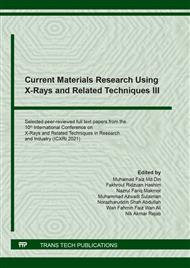[1]
Witt, Devin, Ma, Kai-Tung, Lee, Tim, Gaylarde, Christine, Celikkol, Sukriye, Makama, Zakari, and Iwona Beech. Field Studies of Microbiologically Influenced Corrosion of Mooring Chains." Paper presented at the Offshore Technology Conference, Houston, Texas, USA, OTC-27142-MS, May 2016. 1-18.
DOI: 10.4043/27142-ms
Google Scholar
[2]
N Hasim, NS Azmi, WFF Wan Ali, E Hamzah, A Yahya, MA Mat Yajid, Temperature Effect on Pseudomonas Aeruginosa Growth and Its Presence on Corrosion of Steel Wire Rope, Mater. Sci. Forum 1010 (2020) 92-97.
DOI: 10.4028/www.scientific.net/msf.1010.92
Google Scholar
[3]
Mahdi K., Abbas B., Afrouzossadat H.A., Meysam K., and Pyeman T., Microbiologically Influenced Corrosion of a Pipeline in a Petrochemical Plants., Metals, 459(9), 2019, 1-14.
Google Scholar
[4]
Yuta Inaba, Shirley Xu, Jonathan T Vardner, Alan C. and Scott B., Microbially influenced corrosion of stainless steel by Acidithiobacillus Ferrooxidans Supplemented with Pyrite: Importance of Thiosulfate., Appl. Env. Microbiology. 85(21) 2019 1-13.
DOI: 10.1128/aem.01381-19
Google Scholar
[5]
Jason S.L., and Brenda J.L, A Mechanistic Approach to Understanding Microbiologically Influenced Corrosion by Metal-Depositing Bacteria, Corr. 75(1) 2019, 6-11.
DOI: 10.5006/2899
Google Scholar
[6]
Li, S. Y.; Kim, Y. G.; Jeon, K. S.; Kho, Y. T.; Kang, T. (2001). Microbiologically Influenced Corrosion of Carbon Steel Exposed to Anaerobic Soil. Corr. 57(9), 815–828.
DOI: 10.5006/1.3280616
Google Scholar
[7]
Mardhiah I., Norhazilan M.D., Nordin Y., Arman A., and Ahmad Safuan A.R., The effect of pH and Temperature on Corrosion of Steel Subject to Sulphate-reducing Bacteria, J. Env. Sci. Tech. 7(4) (2014) 209-217.
Google Scholar
[8]
Tran T., Kannorpatti K., Padovan A., and Thennadil S., Effect of pH regulation by sulfate-reducing bacteria on corrosion behavior of duplex stainless steel 2205 in acidic artificial seawater., R. Soc. Open Sci. 8 (2021) 200639.
DOI: 10.1098/rsos.200639
Google Scholar
[9]
Shuan Liu, Huyuan Sun, Lijuan Sun and Huiji Fan, Effect of pH and Cl- concentration on corrosion behavior of the galvanized in simulated rust layer solution, Corr. Sci. 65 (2012) 520-527.
DOI: 10.1016/j.corsci.2012.08.056
Google Scholar
[10]
Bolton, N., Critchley M., Fabien R., Cromar N., and Fallowfield H., Microbially influenced corrosion of galvanized steel in aerobic water system, J. Appl. Microbiology. 109 (2010) 239-247.
DOI: 10.1111/j.1365-2672.2009.04650.x
Google Scholar
[11]
Khulood Abid and Hayfa A.Abas, Corrosion study of galvanized steel in salty acidic and basic solution, Dirasat Pure Sci. 39(1) (2013) 108-116.
Google Scholar
[12]
S.R. Kunst. G.A. Ludwig, M.R. Ortega and C.F. Malfatti, The influence of adding corrosion inhibitor and pH on the electrochemical properties of hybrid films applied to galvanized steel. Ingenieria E., Investigacion, 33(3) (2013) 17-21.
DOI: 10.15446/ing.investig.v33n3.41035
Google Scholar


